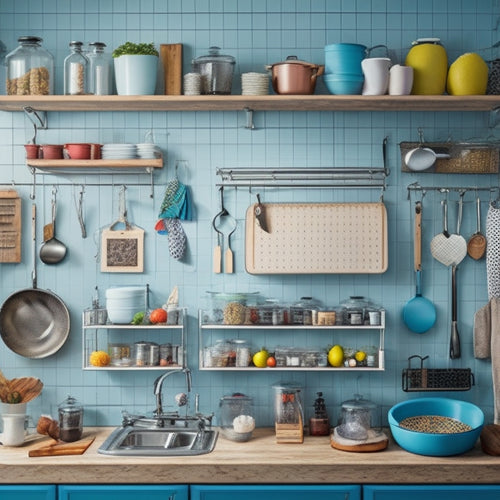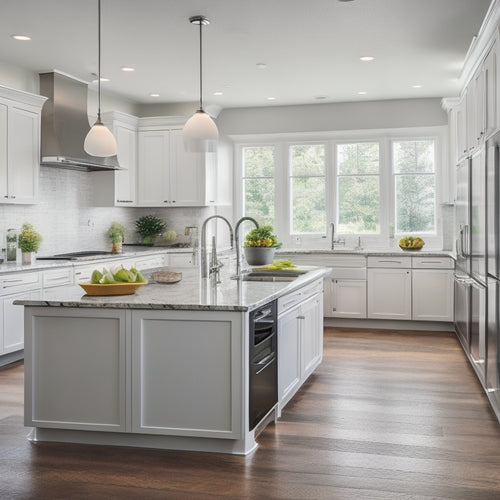
What's Hiding in Your Kitchen Utensil Drawer?
Share
You've got a kitchen utensil drawer that's hiding a cluttered mess of outdated gadgets, forgotten tools, and disorganized essentials. Take a closer look and you'll likely find space-wasting utensils that are no longer useful, innovative gadgets that can simplify cooking tasks, and essential tools that are hard to find. Your drawer may be cluttered, but with a little organization, you can categorize utensils, assign a spot for each one, and maximize storage capacity. By streamlining your kitchen utensil storage, you'll uncover a more efficient and effective cooking space - and discover even more opportunities to optimize your kitchen workflow.
Key Takeaways
• Outdated utensils are hiding in your kitchen drawer, taking up valuable space and turning it into a cluttered utensil graveyard.
• Hidden gems like silicone spatulas with built-in thermometers and garlic presses with built-in crushers can simplify cooking tasks and make meal prep more efficient.
• A cluttered utensil drawer can be organized by categorizing utensils into groups, using drawer dividers, and assigning a specific spot for each tool.
• Maximizing storage capacity in your utensil drawer involves using dividers, installing adjustable inserts, and optimizing vertical space to prioritize frequently used items.
• Streamlining your kitchen utensil storage requires categorizing items by frequency of use, size, and function, and utilizing kitchen hacks like adhesive magnets or hooks to keep items accessible.
Outdated Utensils Taking Up Space
You're likely holding onto outdated utensils that are taking up valuable space in your kitchen utensil drawer, serving no purpose other than to clutter your kitchen. It's time to acknowledge that these space wasters have turned your utensil drawer into an utensil graveyard.
Take a closer look and you'll find gadgets and tools that are no longer useful or have been replaced by newer, better versions. Be honest with yourself - do you really need that broken spatula or the can opener that's been collecting dust for years? Probably not.
By holding onto these outdated utensils, you're not only cluttering your kitchen but also preventing yourself from having a more organized and functional space. It's time to declutter and take control of your kitchen utensil drawer.
Start by sorting your utensils into three piles: keep, donate/sell, and discard. Be ruthless - if you haven't used it in the past year, it's probably safe to get rid of it.
Hidden Kitchen Tools and Gadgets
Beyond the essentials, your kitchen utensil drawer likely holds a treasure trove of hidden tools and gadgets that can elevate your cooking experience. You might be surprised at the innovative gadgets hiding in plain sight. Take a closer look and discover the gems that can simplify your cooking tasks and make meal prep a breeze.
| Gadget Innovation | Kitchen Hacks |
|---|---|
| Silicone spatula with built-in thermometer | Measure meat temps with ease |
| Garlic press with built-in crusher | Crush garlic cloves without the mess |
| Microplane grater with detachable container | Grate cheese and zest citrus with precision |
These gadgets can help you cook more efficiently and effectively. The silicone spatula with a built-in thermometer ensures your meat is cooked to perfection, while the garlic press with a built-in crusher saves you time and effort. The microplane grater with a detachable container makes grating cheese and zesting citrus a cinch. By utilizing these hidden tools, you'll be whipping up restaurant-quality dishes in no time. So, take inventory of your kitchen utensil drawer and maximize the full potential of your cooking skills.
Cluttered Utensil Drawer Organization
Now that you've uncovered the hidden gems in your kitchen utensil drawer, it's time to tackle the clutter and organize your tools in a way that makes sense for your cooking style. You want to create a system that allows you to find what you need quickly and easily, without having to dig through a jumbled mess.
To get started, try these three steps:
-
Categorize your utensils: Group similar items together, such as baking tools, cooking utensils, and servingware. This will help you see what you have and where it should go.
-
Use drawer dividers: Separate your categorized groups with dividers to keep them organized and prevent clutter from building up again.
-
Assign a home for each item: Once you've categorized and divided your utensils, assign a specific spot for each item. This will help you develop a habit of putting things back where they belong.
Overcrowded Countertop Solutions Found
Now that you've tackled your cluttered utensil drawer, it's time to turn your attention to that overcrowded countertop.
By clearing cluttered counter space, you'll be able to optimize storage capacity and streamline your kitchen workflow.
With these solutions, you'll be able to cook, prep, and entertain more efficiently than ever before.
Clear Cluttered Counter Space
You're likely tired of the chaos that comes with a cluttered countertop, where utensils, appliances, and gadgets compete for space, making meal prep a stressful ordeal. It's time to take back control and create a sense of calm in your kitchen.
To clear cluttered counter space, start by designating Kitchen Zones. This means assigning specific areas for different tasks, such as a baking zone, cooking zone, and prep zone.
Here are three essential steps to get you started:
-
Purge and declutter: Remove anything you don't need or use regularly.
-
Assign a home: Designate a specific spot for each item, ensuring everything has a place to go back to.
-
Create Surface Aesthetics: Group similar items together, and consider using a utensil organizer or tray to keep countertops tidy.
Optimize Storage Capacity Now
With your kitchen zones established and cluttered countertops cleared, it's time to maximize storage capacity by tackling the often-neglected kitchen utensil drawer. You're now ready to optimize storage capacity and make the most of this valuable space.
Start by purging items you no longer need or use. Be ruthless – if you haven't used it in the past year, it's likely taking up valuable real estate.
Next, categorize your utensils into groups, such as baking, cooking, and serving. This will help you determine the most efficient way to store them.
Use drawer dividers to separate these categories and keep similar items together. This will make it easy to find what you need when you need it.
Consider using storage bins to store small items like spices, oils, or condiments. Label each bin so you can quickly identify what's inside.
By implementing these strategies, you'll be able to fit more into your utensil drawer, freeing up space elsewhere in your kitchen.
With your utensils organized and easily accessible, you'll feel a sense of control and belonging in your kitchen.
Streamline Kitchen Workflow
By reorganizing your kitchen utensil drawer, you've paved the way to streamline kitchen workflow, allowing you to focus on tackling the next challenge: optimizing your countertops. A cluttered countertop can be overwhelming, making meal prep and cooking a stressful experience.
To maximize your kitchen's productivity, consider these simple yet effective solutions:
-
Designate zones: Allocate specific areas for specific tasks, such as a coffee station or a baking zone, to reduce clutter and increase efficiency.
-
Utilize vertical space: Install shelves, hooks, or a pegboard to hang frequently used items, keeping them within easy reach while freeing up counter space.
-
Implement a 'one in, one out' policy: Make certain that for every new kitchen gadget or appliance you bring in, an old one is removed or donated, maintaining a balanced and organized kitchen.
Streamlining Kitchen Utensil Storage
Organize your kitchen utensil storage by categorizing items into groups based on frequency of use, size, and function to create a logical and accessible layout. This simple step can make a huge difference in your kitchen workflow. By grouping similar items together, you'll be able to find what you need quickly and easily, reducing frustration and saving time.
Next, use kitchen hacks like adhesive magnets or hooks to hang items like utensils, spices, or oven mitts, keeping them off the countertops and out of the way. This smart storage solution will free up space and create a sense of calm in your kitchen.
Consider using dividers or baskets to separate items within your utensil drawer, keeping them organized and easy to access. By implementing these strategies, you'll be able to maintain a clutter-free kitchen and enjoy a sense of belonging in your cooking space.
With a streamlined utensil storage system, you'll be more efficient, productive, and happy in the kitchen.
Maximizing Drawer Storage Capacity
To maximize your kitchen utensil drawer's storage capacity, assess the available space and measure it carefully to determine the most efficient layout and arrangement of your utensils and storage solutions. This will help you identify areas where you can optimize storage and make the most of the space you have.
Here are three ways to maximize your drawer's storage capacity:
-
Use Drawer Dividers: These will help you separate your utensils into categories, making it easier to find what you need when you need it. You can use adjustable dividers to customize the sections to fit your specific utensils.
-
Install Adjustable Inserts: These can be customized to fit your specific drawer and utensils, providing a snug and secure fit. Adjustable inserts can also be rearranged as your utensil collection changes.
-
Optimize Vertical Space: Make the most of your drawer's vertical space by using stackable containers or inserts. This will help you store more utensils in a smaller area, keeping your drawer organized and clutter-free.
Essential Utensils Within Reach
Essential Utensils Within Reach
You'll want to store your most frequently used utensils in easy-to-reach locations, allowing you to quickly grab what you need without having to dig through the entire drawer. This will save you time and energy, making your cooking experience more enjoyable and efficient.
To achieve this, prioritize your utensils based on frequency of use and categorize them into "must-haves" and "nice-to-haves". Here's a suggested categorization:
| Utensil Priorities | Kitchen Efficiency Tips |
|---|---|
| Must-haves: Spatula, Whisk, Can Opener | Store in front and center of the drawer for easy access |
| Must-haves: Kitchen Shears, Measuring Cups | Place near the front for frequent use |
| Nice-to-haves: Garlic Press, Pastry Brush | Store towards the back for occasional use |
| Nice-to-haves: Fondue Forks, Cake Tester | Consider storing in a separate drawer or container |
| Miscellaneous: Gadgets, Specialty Tools | Store in a separate container or on a pegboard |
Frequently Asked Questions
Can I Donate or Repurpose Old Kitchen Utensils?
You can breathe new life into old kitchen utensils by donating gently used items or getting creative with upcycling projects, exploring eco-friendly alternatives that reduce waste and foster a sense of community.
How Often Should I Clean My Utensil Drawer?
You should clean your utensil drawer during Spring Cleaning and maintain daily habits like wiping it down after meals to prevent crumbs and spills from building up, keeping it organized and hygienic.
Are Silicone Utensils Better Than Stainless Steel?
Did you know 70% of home cooks prefer silicone utensils? You'll likely join them, as silicone utensils outperform stainless steel in heat resistance and non-stick performance, making cooking and cleaning a breeze for you.
Can I Store Sharp Objects in a Utensil Drawer?
You'll want to prioritize Safety Risks when storing sharp objects; consider Storage Solutions like dividers, inserts, or a designated sharp-utensil tray to keep them organized and out of harm's way, ensuring a safe and peaceful kitchen environment.
How Do I Prevent Utensil Drawer Dividers From Shifting?
Did you know 75% of homeowners struggle with cluttered utensil drawers? To prevent dividers from shifting, you'll create utensil stability by using adjustable drawer organizers with non-slip bases, ensuring your kitchen essentials stay sorted and within reach.
Related Posts
-

Boost Productivity With Free Google Sheets Templates
You can enhance your productivity exponentially by utilizing free Google Sheets templates, which offer a proven way t...
-

Why Cluttered Kitchens Need Better Tool Storage
You're likely wasting around 30 minutes a day searching for misplaced kitchen tools or utensils, which is equivalent ...
-

5 U-Shaped Kitchen Layout Ideas to Revamp Your Space
You're about to reveal the secret to a kitchen that's both stunning and supremely functional, where every inch of spa...


